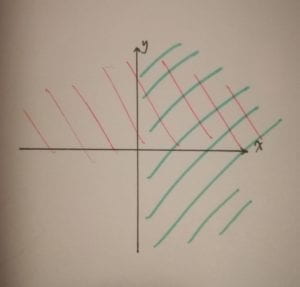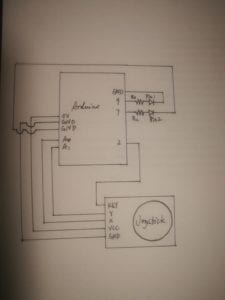Exercise
For this recitation, me and my partner picked a joystick as the sensor that we study and practice on. We decided to use two LEDs to show the output driven by the sensor: We wanted one LED indicate the input data from x axis potentialmeter, and the other indicate y axis. We used two LEDs of different colors, red and green, to show the position of the joystick; Ideally, the red LED will light up when the joystick (which is set vertically) moves upward, and the green one will light up when it moves right ward.
 ideal setting
ideal setting
We connected the circuit following the diagram below:
 Diagram
Diagram
Imitating the coding process of mapping analog inputs in class, we programmed the arduino and experimented whether it works, but the serial monitor showed unreadable digital gebberish, and the LEDs did not light up.
With the help from the faculty, we found that the Baud rate we copied from the example on the website (115200) did not match our required one (9600). After fixing this, the monitor shows readable data, but the LEDs still refused to light up.
We debugged the circuit again, finding that we had connected the LEDs in a short circuit. When we removed this problem, the circuit finally works as we expected.
Questions
Question 1:
What did you intend to assemble in the recitation exercise? If your sensor/actuator combination were to be used for pragmatic purposes, who would use it, why would they use it, and how could it be used?
We intended to create some kind of output that can indicate the movement of the joystick, but after building and reflecting, we found it more like two displayers controlled by the joystick. I don’t think our sensor/actuator can be directly used pragmatically because it is not able to quantify through direct, sensible output, but it may be used for delivering information of the status of hand shanks to workers from a distance if it can be improved (for example, adding more indicating LEDs of different colors to represent every quadrant).
Question 2:
Code is often compared to following a recipe or tutorial. Why do you think that is?
I think this is because both recipe/tutorial and code has to be implemented step by step. If there is one error, then the process is unaccessible, or the result will be wrong.
Question 3:
In Language of New Media, Manovich describes the influence of computers on new media. In what ways do you believe the computer influences our human behaviors?
I think the most noteworthy impact of computers on human is that they cut down the necessity of doing recurring, calculative work. This kind of work usually occupies a lot of human energy and time, requiring not creativity but mechanical repetition. Computers do not only free human from them, but also do faster and more accurately. Therefore, we tend to value more of innovative and creative ideas that only human can achieve. In other words, we become lazier in the aspect of “leg” work, more attentive in mind work.